In the vast arena of education, one strategy stands out in terms of fostering focus, drive, and success – the art of setting SMART goals. Whether you're a seasoned educator or a novice, understanding and implementing SMART goals is a game-changer. This article is designed to walk you through the concept, benefits, examples and application of SMART goals in all settings. Keep reading.
In the world of personal and professional growth, setting clear and attainable goals is paramount. Whether you're striving for a promotion, working on a personal project, or simply want to improve in a certain area of your life, having a roadmap that outlines your desired outcomes can make a world of difference. This is where SMART goals come in handy.
Unveiling SMART Goals
SMART is an acronym that stands for Specific, Measurable, Attainable, Relevant, and Time-bound. This goal-setting strategy is designed to provide clarity, focus, motivation, and the tools necessary for tracking your progress. As such, SMART goals take into account all the essentials that make goal-setting effective and fruitful.
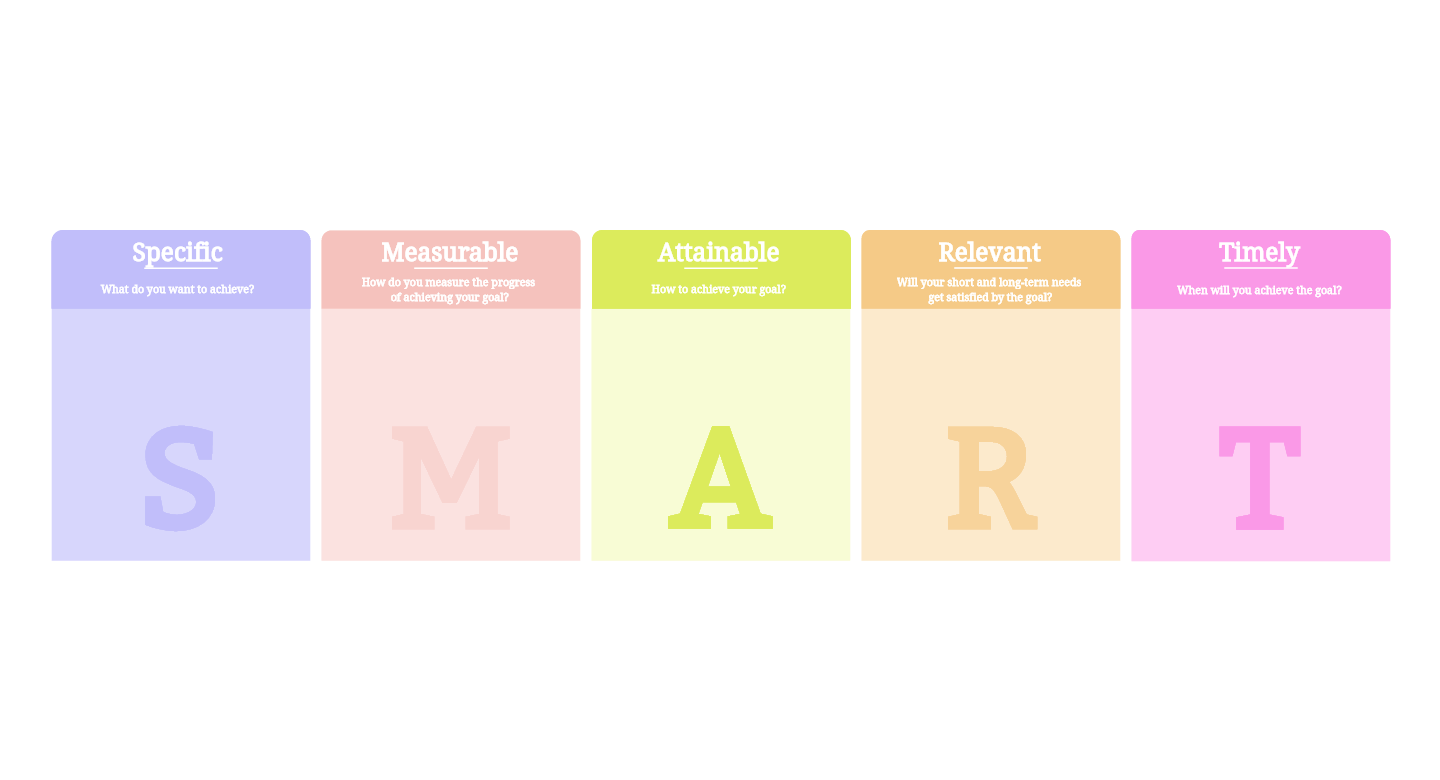
Specific
Goals need to be clear and specific to ensure a better path towards success. Instead of having vague objectives like "I want to lose weight," a specific goal could be "I want to lose 10 pounds in 3 months by cutting out sugary drinks and hitting the gym 3 times a week." With a specific goal, you know exactly what you need to do and the steps you need to take.
Measurable
To ensure that a goal is measurable, it needs to answer questions such as "How much?" or "How many?" It provides concrete criteria for tracking progress. In the case of our previous example, the measurable aspect is the 10 pounds you want to lose.
Attainable
An attainable goal is one that you have enough time and resources to reach. It's good to have high aspirations but setting a goal that's impossible to achieve can do more harm than good. It could lead to frustration and may even cause you to give up on your goal entirely.
Relevant
Your goals should align with your long-term objectives. This makes it easier for you to stay committed and motivated along the way. If you are trying to live a healthier lifestyle, then losing weight could be a relevant goal for you.
Time-bound
Having a deadline can help prevent day-to-day tasks from taking precedence over your longer-term goals. In our example, the time-bound aspect is the 3-month timeframe given for losing 10 pounds.
Benefits of SMART Goals
- Improves Focus and Clarity: With SMART goals, there's no ambiguity about what you're trying to achieve or when it should be achieved. By making your objectives clear and concise, SMART goals help maintain your focus and give your efforts a clear direction.
- Enhances Motivation: When you have attainable goals that align with your aspirations and values, it's easier to stay motivated and committed. The SMART goals framework can thus act as a catalyst that keeps your motivation alive throughout your journey.
- Encourages Accountability: The measurable element in SMART goals makes it possible for you to track your progress and hold yourself accountable for the outcome. It fosters self-discipline and helps instill a sense of responsibility for reaching your goals.
- Facilitates Efficient Time Management: By setting time-bound goals, you're able to manage your time more efficiently and focus on what needs to be done to achieve your objectives. It promotes better planning and prioritizing, ultimately leading to a higher productivity level.
In conclusion, the SMART goal setting approach provides a practical and structured framework that fosters goal clarity, trackability, attainability, relevance, and timeliness. By leveraging this methodology, you'll be better equipped to navigate your way to success, no matter how big or small your aspirations may be.
10 Realistic SMART Goals Examples for All Walks of Life
Successful goal setting can often mean the difference between failure and success in any field. One strategy that has proven to be especially effective is SMART goal setting, which provides a structure for goals to make them clear, actionable, and achievable. Below, we have detailed 10 examples of SMART goals for different groups of people and industries.
SMART Goals Examples for College Students
General Goal: Improve Time Management Skills
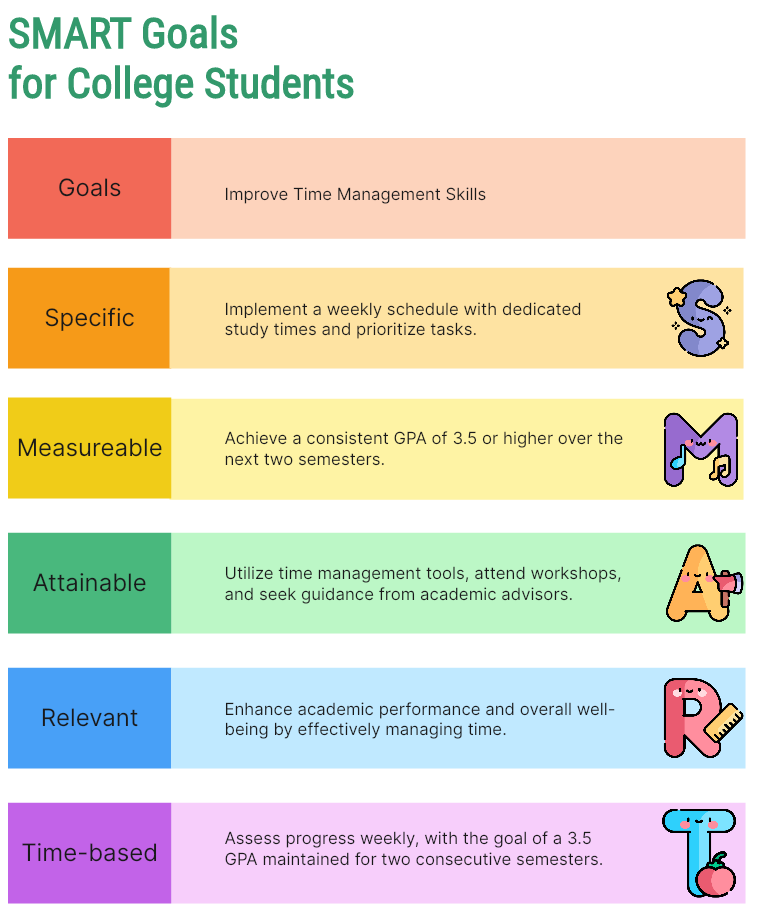
- Specific (S): Implement a weekly schedule with dedicated study times and prioritize tasks.
- Measurable (M): Achieve a consistent GPA of 3.5 or higher over the next two semesters.
- Achievable (A): Utilize time management tools, attend workshops, and seek guidance from academic advisors.
- Relevant (R): Enhance academic performance and overall well-being by effectively managing time.
- Time-bound (T): Assess progress weekly, with the goal of a 3.5 GPA maintained for two consecutive semesters.
SMART Goals Examples for Middle School Students
General Goal: Develop Stronger Study Habits
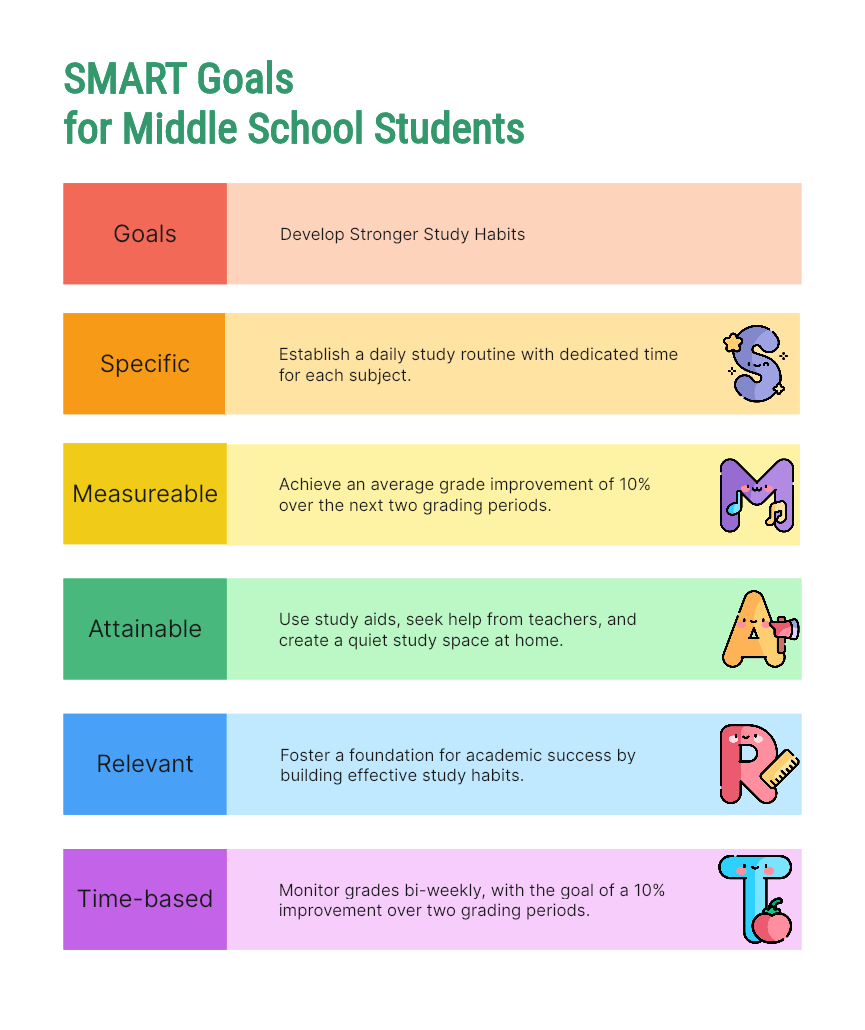
- Specific (S): Establish a daily study routine with dedicated time for each subject.
- Measurable (M): Achieve an average grade improvement of 10% over the next two grading periods.
- Achievable (A): Use study aids, seek help from teachers, and create a quiet study space at home.
- Relevant (R): Foster a foundation for academic success by building effective study habits.
- Time-bound (T): Monitor grades bi-weekly, with the goal of a 10% improvement over two grading periods.
SMART Goals Examples for Nursing Students
General Goal: Improve Clinical Skills
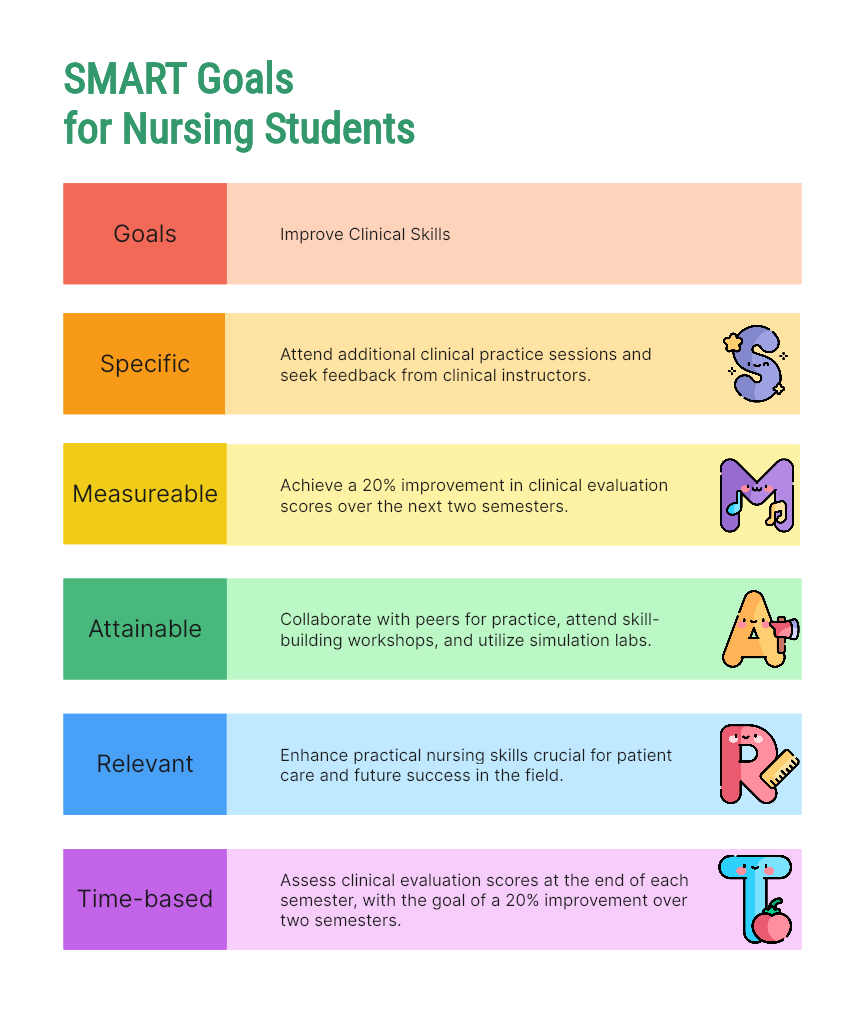
- Specific (S): Attend additional clinical practice sessions and seek feedback from clinical instructors.
- Measurable (M): Achieve a 20% improvement in clinical evaluation scores over the next two semesters.
- Achievable (A): Collaborate with peers for practice, attend skill-building workshops, and utilize simulation labs.
- Relevant (R): Enhance practical nursing skills crucial for patient care and future success in the field.
- Time-bound (T): Assess clinical evaluation scores at the end of each semester, with the goal of a 20% improvement over two semesters.
SMART Goals Examples for Teachers
General Goal: Enhance Classroom Technology Integration
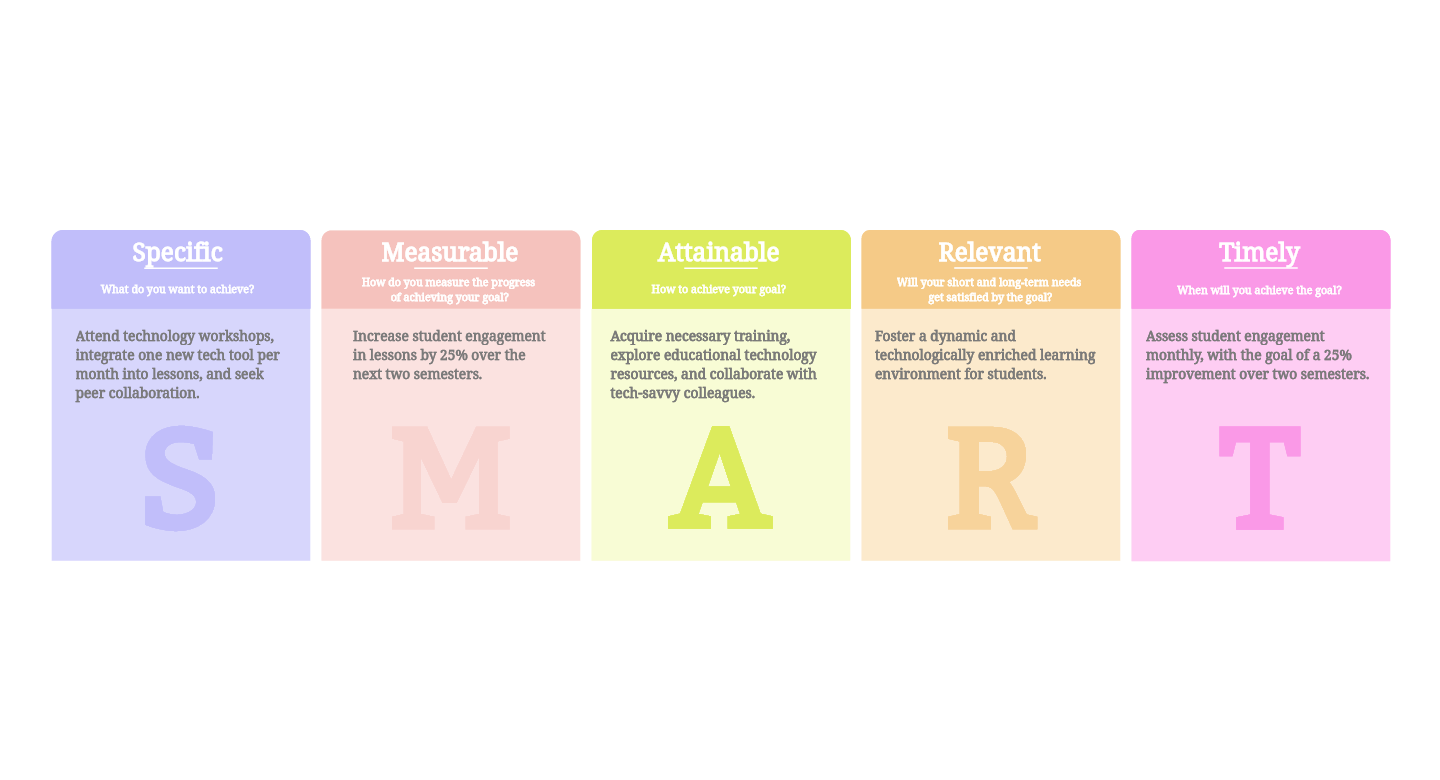
- Specific (S): Attend technology workshops, integrate one new tech tool per month into lessons, and seek peer collaboration.
- Measurable (M): Increase student engagement in lessons by 25% over the next two semesters.
- Achievable (A): Acquire necessary training, explore educational technology resources, and collaborate with tech-savvy colleagues.
- Relevant (R): Foster a dynamic and technologically enriched learning environment for students.
- Time-bound (T): Assess student engagement monthly, with the goal of a 25% improvement over two semesters.
SMART Goals Examples for Work
General Goal: Improve Time Efficiency in Task Completion
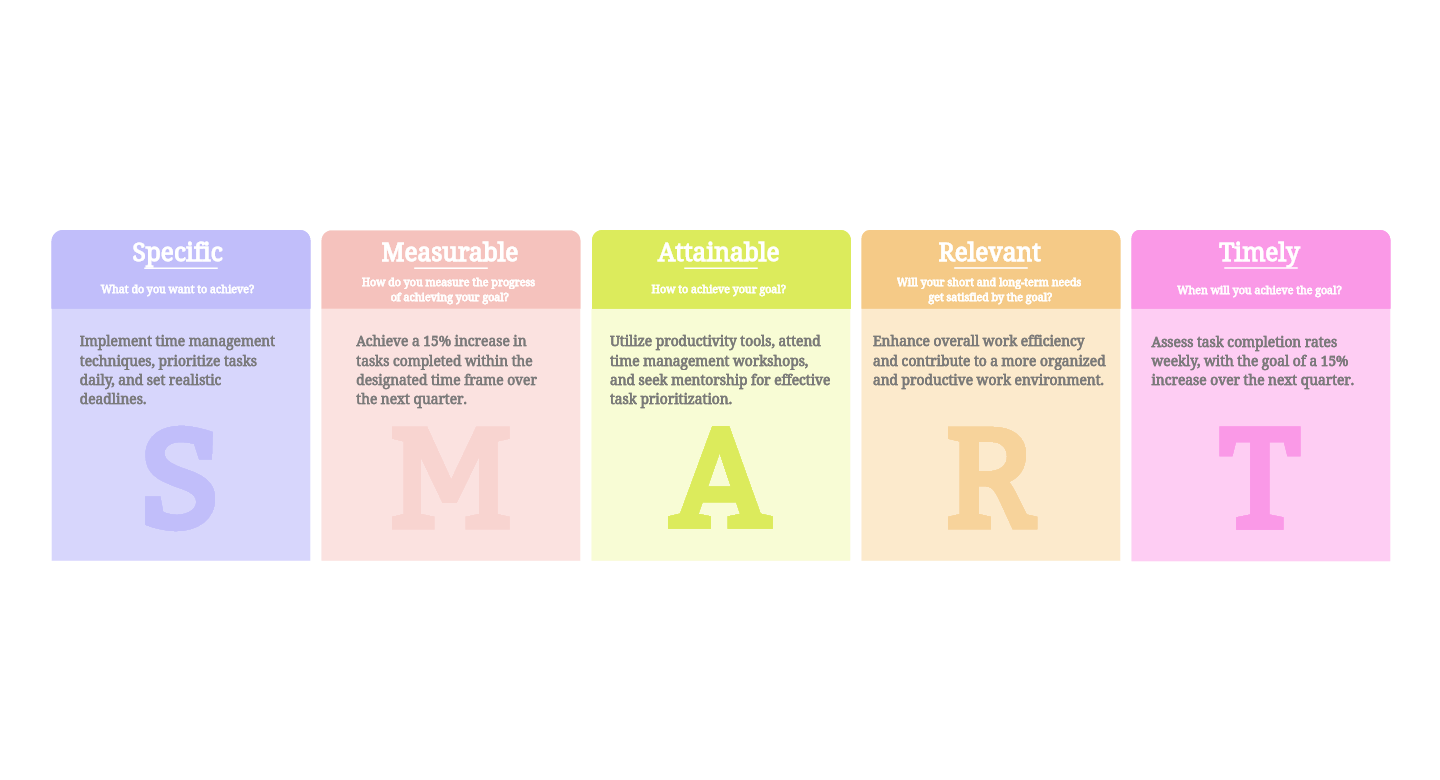
- Specific (S): Implement time management techniques, prioritize tasks daily, and set realistic deadlines.
- Measurable (M): Achieve a 15% increase in tasks completed within the designated time frame over the next quarter.
- Achievable (A): Utilize productivity tools, attend time management workshops, and seek mentorship for effective task prioritization.
- Relevant (R): Enhance overall work efficiency and contribute to a more organized and productive work environment.
- Time-bound (T): Assess task completion rates weekly, with the goal of a 15% increase over the next quarter.
SMART Goals Examples for Employees
General Goal: Enhance Professional Development Opportunities
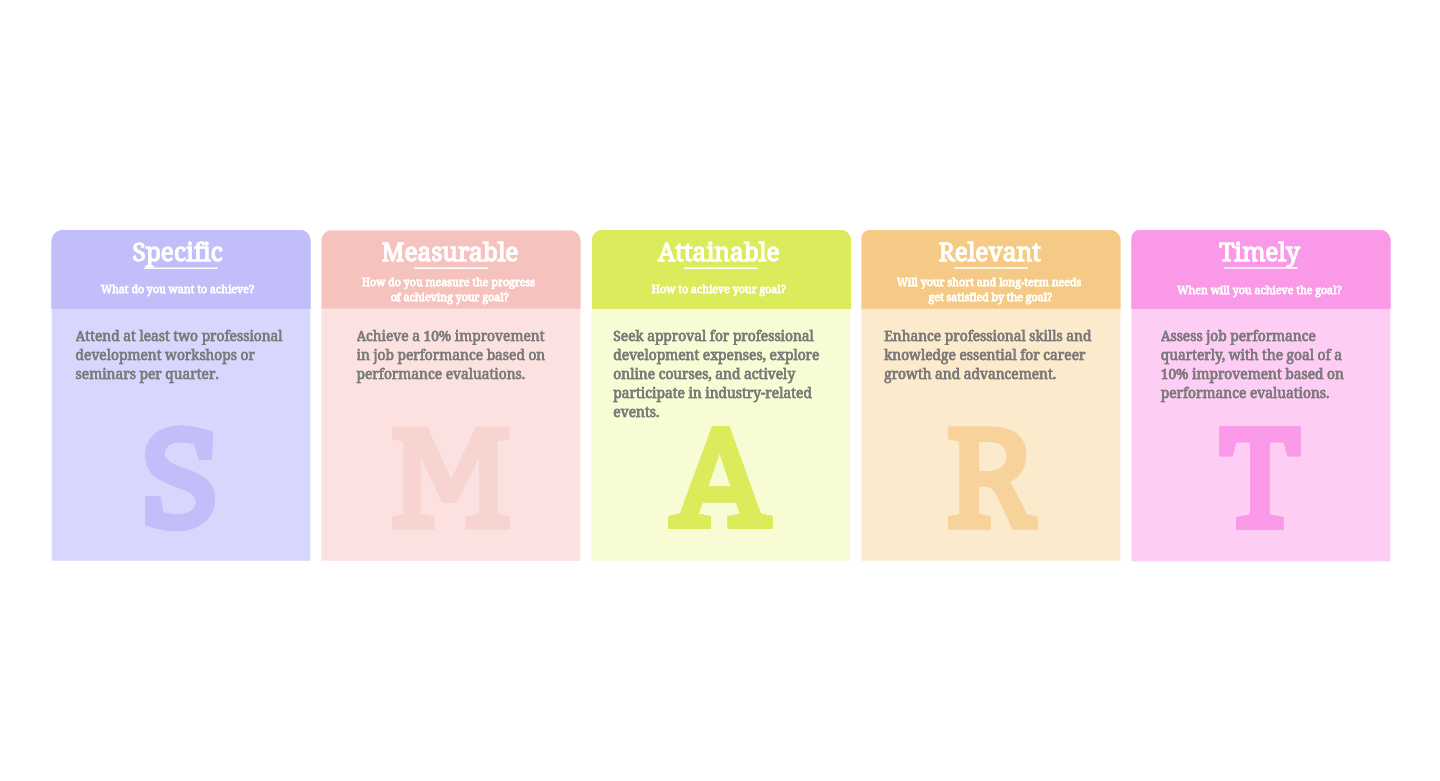
- Specific (S): Attend at least two professional development workshops or seminars per quarter.
- Measurable (M): Achieve a 10% improvement in job performance based on performance evaluations.
- Achievable (A): Seek approval for professional development expenses, explore online courses, and actively participate in industry-related events.
- Relevant (R): Enhance professional skills and knowledge essential for career growth and advancement.
- Time-bound (T): Assess job performance quarterly, with the goal of a 10% improvement based on performance evaluations.
SMART Goals Examples for Nurses
General Goal: Enhance Patient Care Documentation
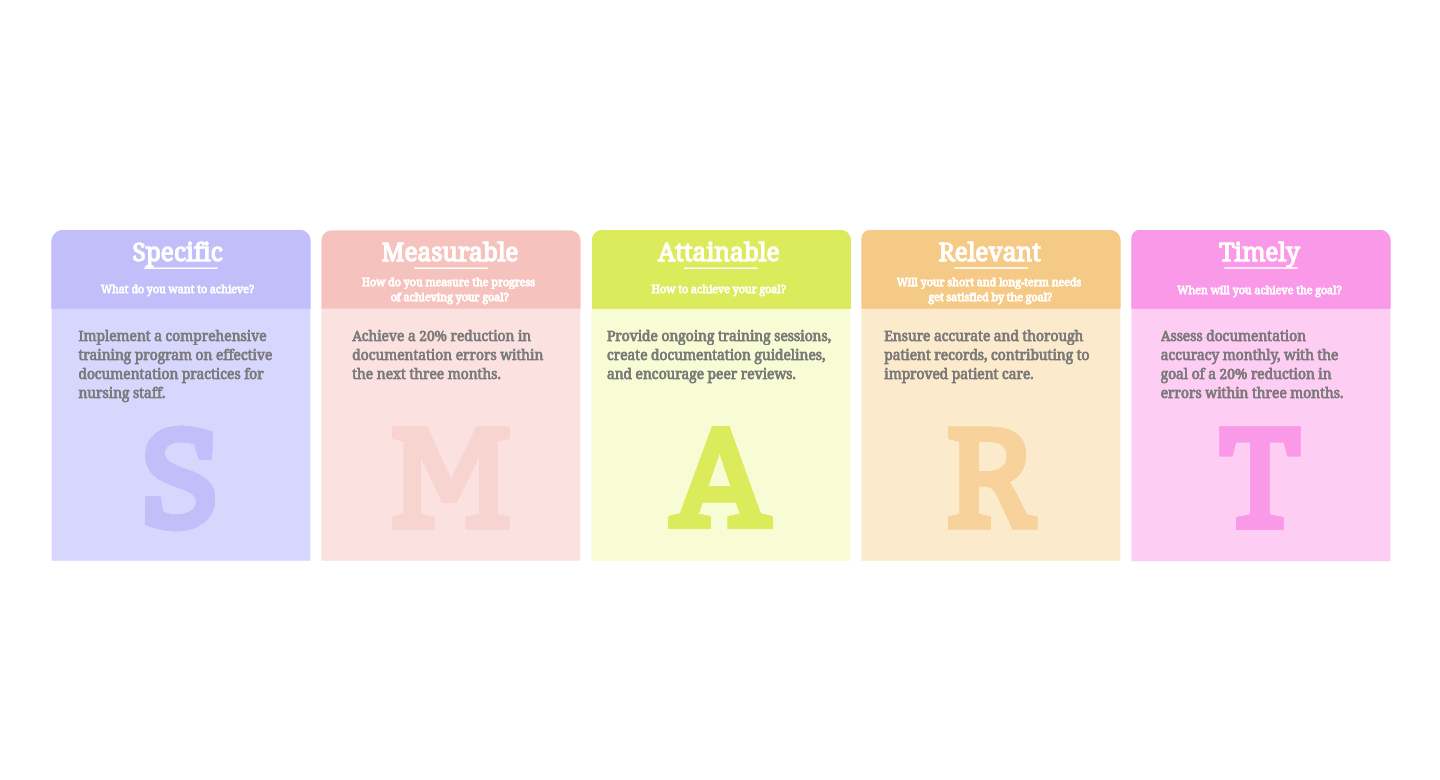
- Specific (S): Implement a comprehensive training program on effective documentation practices for nursing staff.
- Measurable (M): Achieve a 20% reduction in documentation errors within the next three months.
- Achievable (A): Provide ongoing training sessions, create documentation guidelines, and encourage peer reviews.
- Relevant (R): Ensure accurate and thorough patient records, contributing to improved patient care.
- Time-bound (T): Assess documentation accuracy monthly, with the goal of a 20% reduction in errors within three months.
SMART Goals Examples for Businesses
General Goal: Improve Customer Satisfaction Ratings

- Specific (S): Implement a customer feedback system and conduct regular surveys to identify areas for improvement.
- Measurable (M): Achieve a 15% increase in customer satisfaction ratings within the next quarter.
- Achievable (A): Train employees on customer service best practices, address identified issues, and implement customer-focused initiatives.
- Relevant (R): Enhance customer loyalty and retention, contributing to long-term business success.
- Time-bound (T): Review customer satisfaction scores monthly, with the goal of a 15% increase within the next quarter.
SMART Goals Examples for Businesses
General Goal: Develop Leadership Skills
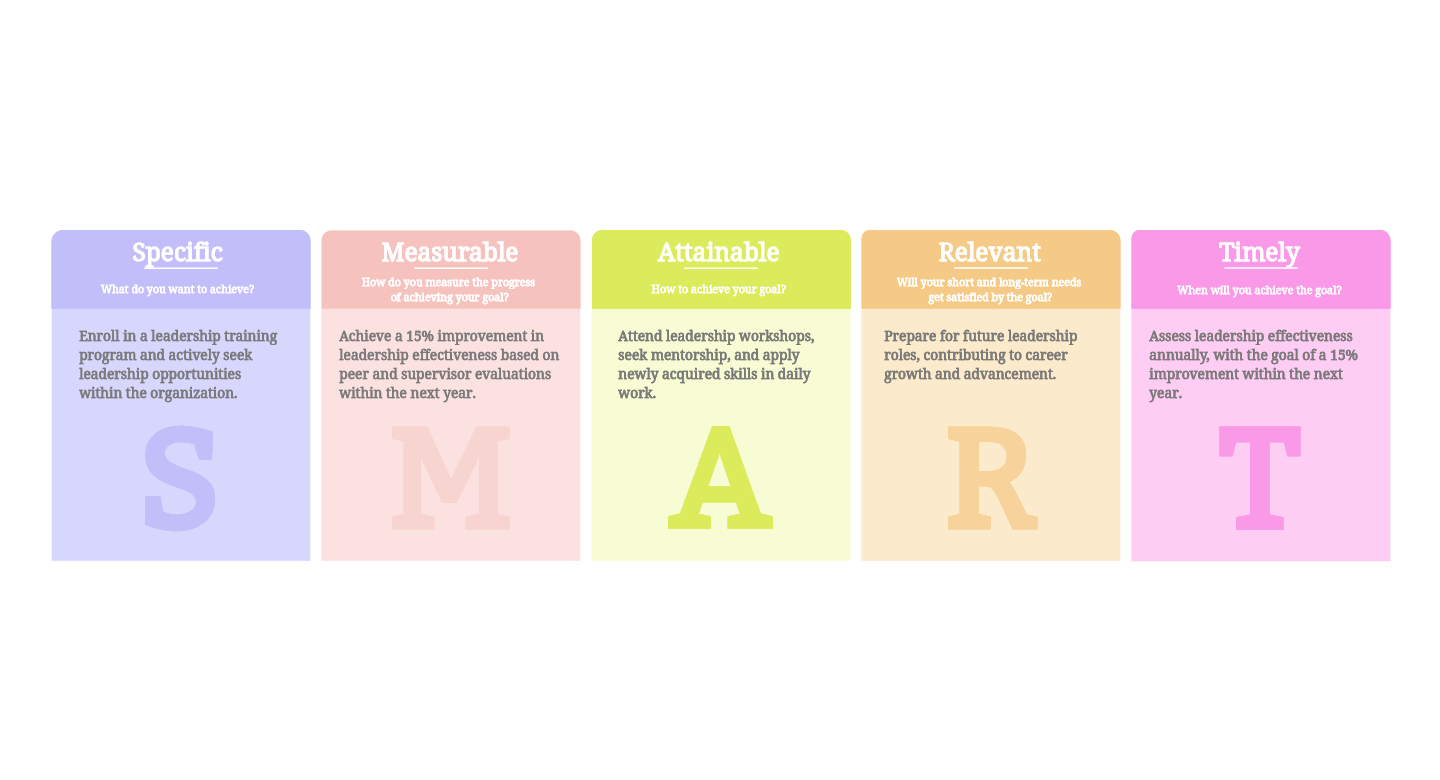
- Specific (S): Enroll in a leadership training program and actively seek leadership opportunities within the organization.
- Measurable (M): Achieve a 15% improvement in leadership effectiveness based on peer and supervisor evaluations within the next year.
- Achievable (A): Attend leadership workshops, seek mentorship, and apply newly acquired skills in daily work.
- Relevant (R): Prepare for future leadership roles, contributing to career growth and advancement.
- Time-bound (T): Assess leadership effectiveness annually, with the goal of a 15% improvement within the next year.
SMART Goals Examples for Health
General Goal: Improve Physical Fitness
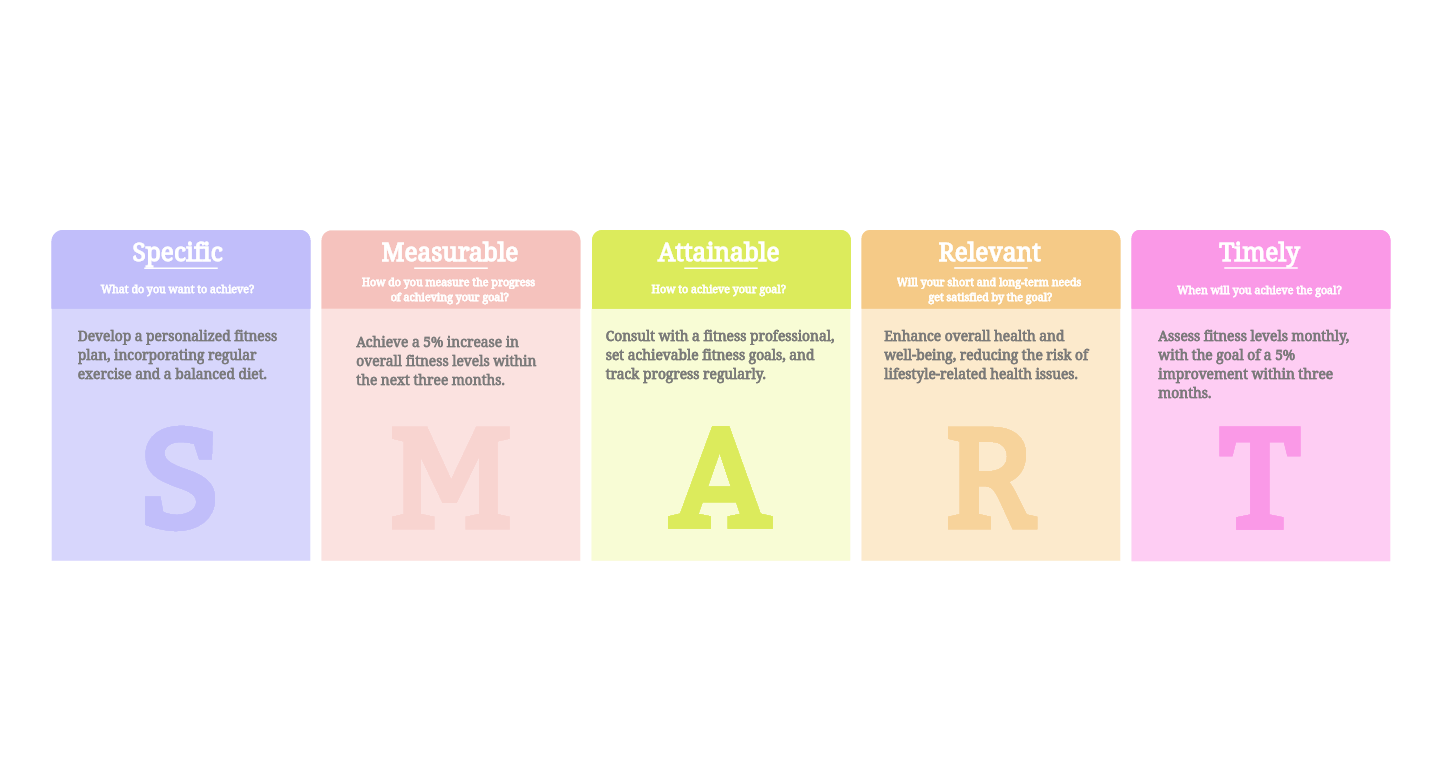
- Specific (S): Develop a personalized fitness plan, incorporating regular exercise and a balanced diet.
- Measurable (M): Achieve a 5% increase in overall fitness levels within the next three months.
- Achievable (A): Consult with a fitness professional, set achievable fitness goals, and track progress regularly.
- Relevant (R): Enhance overall health and well-being, reducing the risk of lifestyle-related health issues.
- Time-bound (T): Assess fitness levels monthly, with the goal of a 5% improvement within three months.
How Do You Write a SMART Goal Statement
Writing a SMART goal is a skill that can be honed over time. The process involves critical thinking and a deep understanding of what you want to achieve. By following the SMART goal framework, you can create meaningful objectives that are more likely to lead to success. Here's how you can write a SMART goal statement:
1. Specific
Start by clarifying what you want to achieve. Your goal should be clear, simple, and define who is involved, what you want to accomplish, where and when it will take place, and why it's important.
Example: Instead of saying "I want to get fit," say "I want to lose 15 pounds in the next 4 months by doing cardio workouts 4 days a week at the local gym."
2. Measurable
Your goal should have quantifiable outcomes. This makes it easy to track your progress and determine when the goal has been achieved.
Example: From the specific example above, losing "15 pounds" is the measurable aspect of the goal.
3. Achievable
The goal should be realistic given your current circumstances, resources, and constraints. It's important to stretch your abilities but also remain within the realm of possibility.
Example: If you currently lead a sedentary lifestyle, jumping right into a rigorous 7-day workout routine might be too ambitious. However, starting with manageable workouts 4 days a week, as in the example above, is more achievable.
4. Relevant
Your goal should align with your broader objectives and be worth your time and effort. This alignment enhances your motivation and commitment to achieving the goal.
Example: If you are trying to improve your overall health and wellness, then losing weight by working out regularly at the gym aligns perfectly with this broader objective.
5. Time-Bound
Your goal should have a clearly defined timeline that creates a sense of urgency and prompts action. This helps prevent everyday tasks from pushing your goal to the back burner.
Example: In the specific example above, "the next 4 months" provides a time-bound aspect to the goal.
Bringing It All Together: Your SMART Goal Statement
Based on the elements outlined above, your SMART goal statement becomes:
"I want to lose 15 pounds in the next 4 months by doing cardio workouts 4 days a week at the local gym."
Remember, while this SMART goal example provides a template, it's important to tailor your goals to suit your individual needs and situation. Writing SMART goals takes practice, but once mastered, it becomes a powerful tool for achieving success in both personal and professional spheres.
A One-Stop SMART Goals Maker - Boardmix
To streamline this process and provide a structured platform for crafting and managing these goals, let us introduce you to a one-stop SMART Goals Maker: Boardmix.
Boardmix is a versatile SMART goals maker designed to support individuals and businesses in setting up, tracking, and achieving their objectives. It's a user-friendly tool that combines cutting-edge technology with the time-tested SMART goal methodology.
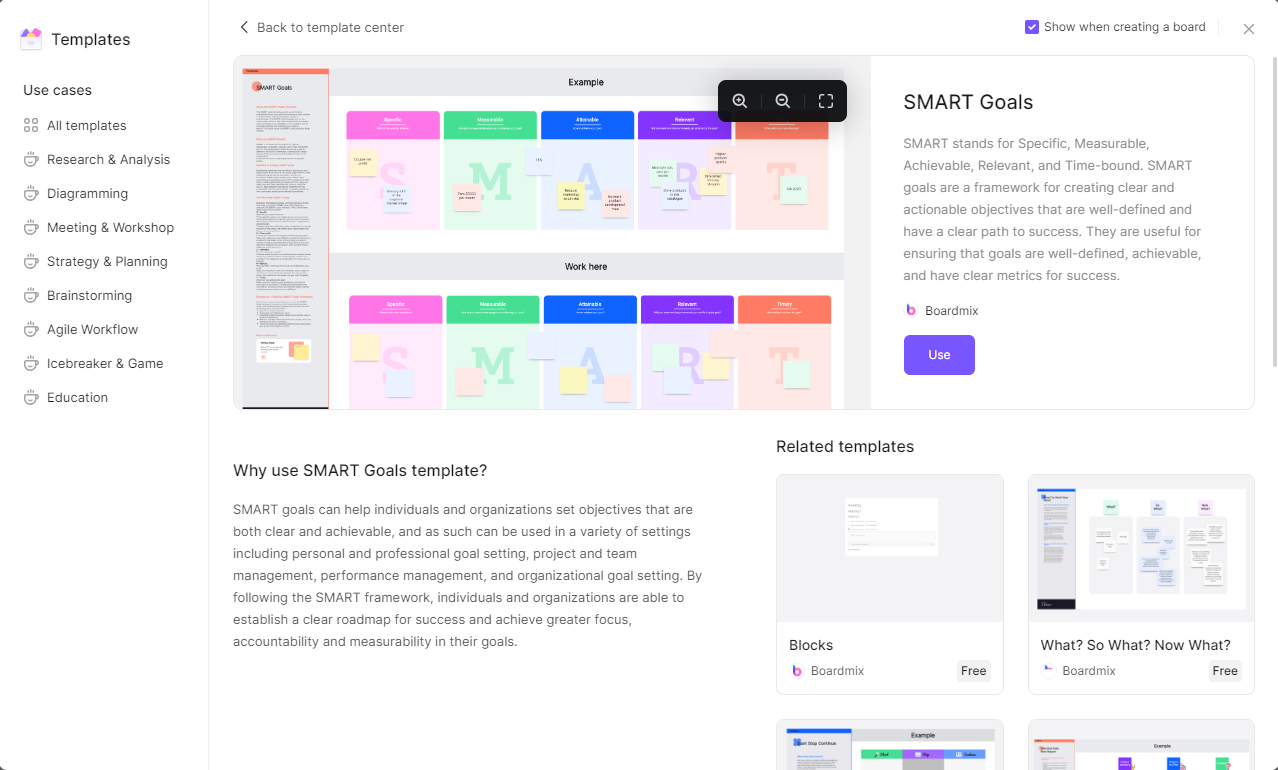
Unique Features of Boardmix
1. Goal Setting
Boardmix simplifies the process of creating SMART goals. By offering helpful templates for each SMART criteria—Specific, Measurable, Achievable, Relevant, and Time-bound—it ensures you articulate your objectives effectively.
2. Goal Tracking
The platform provides real-time progress updates to help you stay on top of your objectives. You can visualize your progress through a graphical representation which promotes transparency and fosters accountability.
3. Collaboration
Boardmix is not just for individuals. It also allows teams to collaborate on shared goals, offering features that allow colleagues to communicate, delegate tasks, and provide updates on their progress. This function significantly enhances teamwork and ensures all members are aligned with the common objective.
4. Integration
Boardmix seamlessly integrates with various other software and platforms such as email clients, calendar apps, and project management tools. This ensures that you have all resources available in one place to manage your goals effectively.
Setting goals is only the first step in achieving success; managing and tracking them is equally critical. Boardmix takes care of all these aspects for you. It enables you to break down your broad visions into specific, measurable actions. Its real-time tracking feature allows you to adjust your strategies when needed, ensuring that you are always moving towards your goals.













